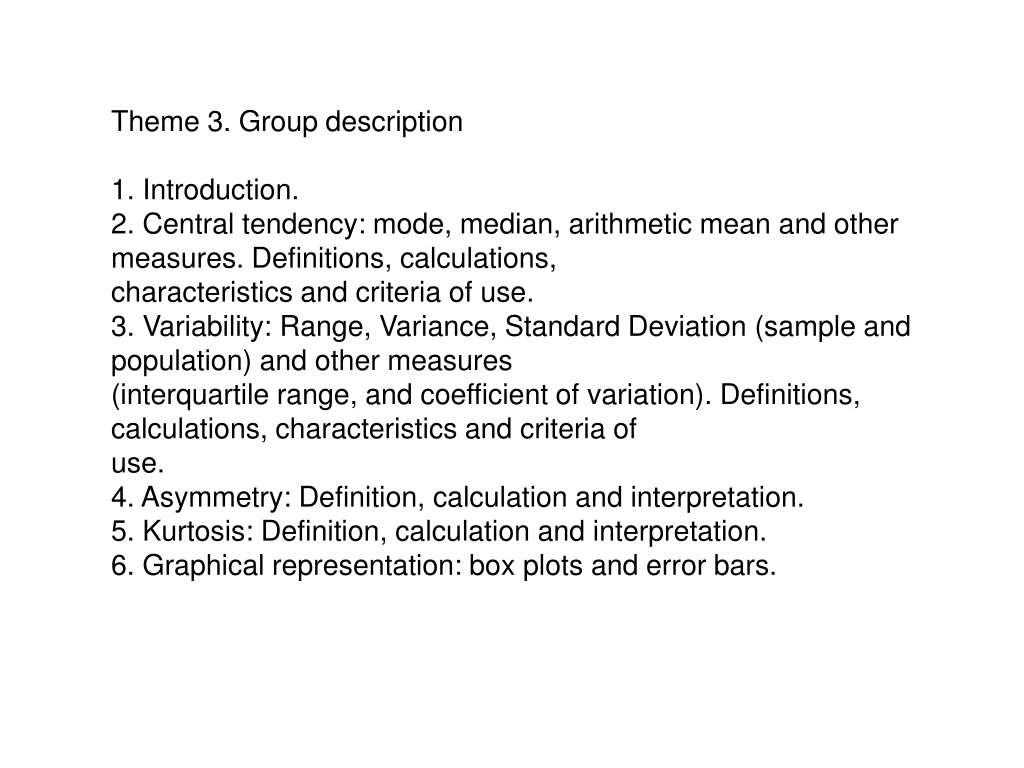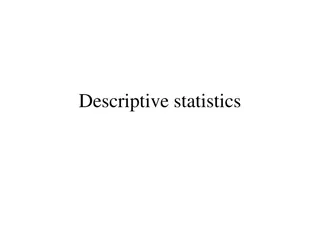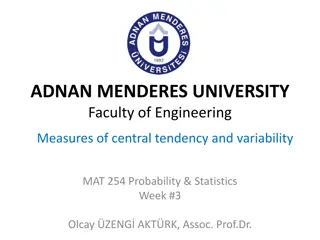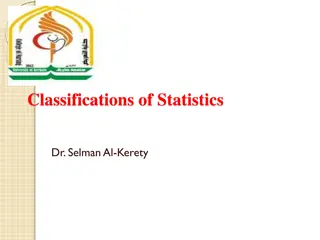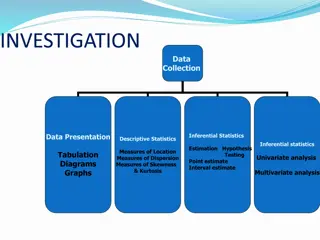Exploring Measures of Central Tendency and Variability in Statistics
Understand the concepts of central tendency (mode, median, mean) and variability (range, variance, standard deviation) in statistics. Explore calculations, characteristics, and criteria of use, along with asymmetry, kurtosis, and graphical representations like box plots. Discover how these statistical measures help analyze and interpret data effectively.
Download Presentation

Please find below an Image/Link to download the presentation.
The content on the website is provided AS IS for your information and personal use only. It may not be sold, licensed, or shared on other websites without obtaining consent from the author. Download presentation by click this link. If you encounter any issues during the download, it is possible that the publisher has removed the file from their server.
E N D
Presentation Transcript
Theme 3. Group description 1. Introduction. 2. Central tendency: mode, median, arithmetic mean and other measures. Definitions, calculations, characteristics and criteria of use. 3. Variability: Range, Variance, Standard Deviation (sample and population) and other measures (interquartile range, and coefficient of variation). Definitions, calculations, characteristics and criteria of use. 4. Asymmetry: Definition, calculation and interpretation. 5. Kurtosis: Definition, calculation and interpretation. 6. Graphical representation: box plots and error bars.
Central Tendency Measures of central tenden indicate a value representative of the bulk of the data: Example: the data 4,7,5,6,5,4,5,5,5,6,5,4,4, it is clear that (by eye) the center is around five, which could be taken as an index of central tendency. We will see 3 most common indices central tendency (mode, mean and median) first. Then we will see other indices.
(Arithmetic) Mean X Formula: i = X n It is simply adding all values, and then that amount is divided by the number of values. If we have the data: 4,6,5,3,7 The mean is (4+6+5+3+7)/5=4 Note: You can use weighted means. Consider that there are 2 data, one (5) weighs 0'6 and the other (6) weighs 0.4. Then, the average will be (5 * 6 * 0.6 + 0.4) / (0.6 + 0.4) = 5'4
Properties of the mean -The Sum of differences (all values) relative to the mean is always 0 -If we add a constant to each of the values, the new arithmetic average result will be the original more the constant. If we multiply each value by a constant, the new arithmetic mean is the original mean multiplied by the constant.
Median The median (MDN or Md) is defined as the middle value in a sortered data set. For example, in the sequence (ordinate) 3,4,5,6,7,8,9 the median is 6 In the sequence (ordinate) 2,3,4,6,7,9 the median is 5 (the arithmetic mean between the two central values, observe that n is even, in the above example it was odd)
Properties of the median -It does not use all the elements -It can be calculated with ordinal data -It is less affected by atypical data than the arithmetic mean.
The mode The Mode (Mo) is defined as that value of the variable corresponding to the higher frequency. In the data set: 4,5,6,6,3,6,4,5 Mo = 6 properties: --It's not necessarily unique (there may be several modes) --It is possible to compute mode with a nominal scale --Its calculation does not involve all elements
Which one shall we use? Mean ModeMedian
Resistence and robustness Resistant statistics: Those who are not influenced (or only slightly) by small changes in the data. Obviously, the average is not resistant to changes in statistical data, since it is influenced by each and every one of them. The median, however, is a highly resistant index.
3. Variability In the previous section we studied several measures (mean, median, etc.) central tendency. Clearly, to know how representative is the value of such a measure of central tendency, it is also necessary to have a measure of variability. For example, someone may have an average of 5 with the following data (5, 4, 6, 5, 5) and another one having an average of 5 to data (10, 0, 5, 9, 1). Obviously the first subject shows less variability.
How can we measure the variability? A first strategy would be to use the formula n ( ) X X i = 1 i n ( ) = 0 X X But it is always zero i = 1 i A second strategy is to use absolute values n X X i = 1 i But it is tricky to use absolute values What is left then? Employ the sum of squared differences .... It is the first step for the variance
Variance Formula 2 n ( ) = X X i 2 = 1 s i n As we will see in the second half (inferential statistics), the variance is a biased estimator of the population variance; therefore the use of "quasivariance" which is the same except that the variance is divided by n-1 is preferred; the quasivariance is an unbiased estimator of population variance: 2 n ( ) X X i = 2 = 1 s i 1 n
Standard deviation 2 2 F rmulae n n ( ) ( ) X X X X i i = = = = 1 i s 1 i s n 1 n An obvious advantage of the standard deviation of the variance is the standard deviation is given in the same units as the original data (in the variance units are squared). NOTE: SPSS always offers the n-1 option (which is the usual one, as it is un unbiased estimator).
Properties of the variance and stand.dev. Variance and SD are essentially positive values. (Notice that the differences on the mean are squared) 2. Neither the variance or desv.t pica are altered when we add a constant. = + = + Y a X Y a X Then we know that i i
= + = + Y a X Y a X Then we know i i 2 2 2 n n n ( ) ( ) ( ) + ) ( + ( ) ) Y Y a X a X X X i i i = = = = 2 y 2 x = = = 1 1 1 s s i i i n n n This applies to the SD as well.
If each data point is multiplied by a constant, the new SD is the original SD multiplied by the absolute value of this constant, and new variance is the original multiplied by the square of that constant = = Y aX Y aX i i 2 2 2 n n n ( ) ( ) ( ) 2 ) Y Y aX aX a X X i i i = = = = 2 y 2 2 = = = 1 1 1 s a s i i i x n n n = s a s y x
Other measures of variability 1. Amplitude (or Range) = It is the difference between the extreme values T A X X max min Its advantage is the simplicity of calculation; the only problem is that it is too sensitive to extreme values
Other measures of variability 2. Semi-interquartile range (Q) JASP indicated the interquartile range , which is just Q3-Q1 It is based on the first and third quartile it is a robust statistics Q Q = 3 1 Q 2 It may be used when the MEDIAN is the best option for central tendency, and it is relatively common (usuallly as interquartile range , a.k.a. IQR). 4. Variation Coefficient Ratio scale Indicates the number of times the deviation average contains mean: the higher the CV greater variability. There are no units, so it allows the comparison between different variables.
Robust measures of variability MAD (Median of Absolute Deviations) The MAD is much more resistant to outliers than the standard deviation. Example: 2,2,3,4,5,6,6 (Mean=4) Absolute deviations: 2, 2, 1, 0, 1, 2, 2. ------ordered 0 1 1 2 2 2 2 MAD=2 (i.e., the median of the absolute deviations) It is often multiplied by a scaling factor to provide (somewhat) similar estimations as the standard deviation this may depend on the underlying distribution. JASP provides this index (both without and with the correction).
4. Asymmetry In the above two points we have seen measures of central tendency and variability. While obtaining such measures is key to describe a sample and make inferences about the population of origin, it is also essential to know the form of a distribution to obtain an adequate characterization of the shape of the data distribution.
Asymmetry While it is easy to have an idea of whether the distribution is symmetrical or not after seeing the graphical representation (e.g., a histogram or a box-and- whisker diagram), it is important to quantify the asymmetry of a distribution. Recall that when data distribution is symmetric, the mean, median and mode match. (And the distribution is the same shape on the left and right of center) While many psychological distributions is assumed that tend to be symmetrical and unimodal distribution in many cases we find it is asymmetric (e.g., distributions of reaction times on almost any task is positive asymmetric).
Positive asymmetry Difficult test Saleries Response times Moda Media Mediana Negative asymmetry Easy test Media Moda Mediana
Index of asymmetry based on moments (SPSS) It is based on the difference of the data on the mean and variance, although this time the coefficients rise are cubed n = 3 ( ) X X n i = 1 i A s 3 x s If the distribution is symmetrical As will be 0 If the distribution is positively skewed, As will be greater than 0 If the distribution is negatively skewed, As will be less than 0 Disadvantage: Very influenced by atypical-scores
Kurtosis It refers to the shape of distribution in relation to a standard, which is the normal distribution. This standard is the normal distribution: mesokurtic distribution. If the distribution is more peaked than the normal distribution we have a leptokurtic distribution. If the distribution is flatter than the normal distribution we have a platykurtic distribution.
Kurtosis IMPORTANT: Kurtosis is independent of the variability (in the sense of "variance"). A leptokurtic distribution is higly peaked in the center (more than the normal distribution ), it decays very rapidly at first, but in the end is somewhat higher than the normal distribution. That means a leptokurtic distribution is more likely to yield more extreme values than the normal distribution.
Example (Mesokurtic distribution-normal) 1200 1000 800 600 400 200 Desv. t p. = 1.01 Media = -.00 N = 10000.00 0 -3.75 -3.25 -2.75 -2.25 -1.75 -1.25 1.25 1.75 2.25 2.75 3.25 3.75 4.25 -.75 -.25 .25 .75 NORMAL
index of kurtosis For a normal distribution (mesokurtic) we know that n 4 ( ) X X n i = = 3 1 i 4 x s And this will be the reference for the index that will employ kurtosis n 4 ( ) X X n i = = 3 1 i C r 4 x s If the distribution is normal (mesokurtic), the index is 0 If the distribution is leptokurtic, the index is greater than 0 If the distribution is platykurtic, the index is less than 0
6. Exploring the central tendency, variability and asymmetry in a graph While it is possible to use different graphics to assess the variability (and central tendency, asymmetry, etc.), it is interesting to use box and whisker diagrams . The box is defined by the first quartile and third quartile, with the median within the box. This will be discussed in detail in practice. Here goes an example from Ratcliff, Perea, Colangelo and Buchanan (2004, Brain & Cognition) (see next slide)
6. Viewing the trend, variability and asymmetry in a graph The median is the thick line inside the boxes (between first and third quartiles). "Atypical" scores are presented individually (see there are two types of outliers). Notice that the controls are clearly different from patients in a "boundary separation" and the "non-decision component", while there is much more overlap in the "quality of information".
6. Viewing the trend, variability and asymmetry in a graph In the case of "drift rate" (patients), the distance between P75 and P50 is much larger than the one between P50 and P25, thus suggesting that there are positive asymmetry. P25 P50 P75 In the case of "non-decision component" (patients), the distance between P75 and P50 is much smaller than that between P50 and P25, suggesting that there is negative asymmetry.
